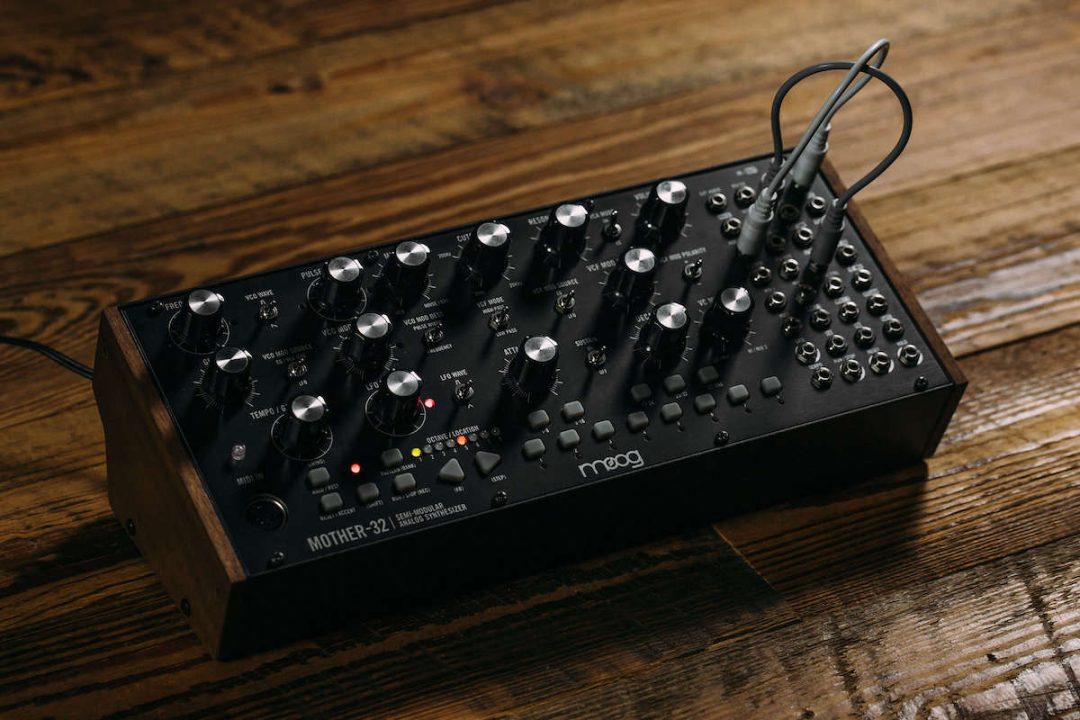The Moog Mother 32 is a semi-modular desktop synthesizer. It’s a great introductory synth for anyone looking to get into modular territory, though it performs just as well as a unique standalone instrument for beginners or veterans alike.
The Moog Mother 32 Does It All
Well, nearly. This semi-modular subtractive synthesizer sculpts rich synthetic timbres by way of a single oscillator and tone-shaping filter. The Moog sound is thoroughly recognizable in this instrument, which is arguably its biggest selling point. Semi-modular design makes it a fun choice for anyone looking to dabble in Eurorack synthesis, but others may find the Moog Mother 32’s flexibility limited overall.
As is the case with Moog branding and quality, the M32 packs a bit of punch in cost for a relativity simple monophonic synthesizer. Still, it makes a great instrument if you take the time to get to know it and its quirks.
Overview of Specs and Features
Filter
Inherent to the sound-shaping abilities of the M32 is its filter. Again, this is a subtractive synthesizer, which means players must make judicious use of the filter to create the tone they’re after. The filter is a 24 dB per octave ladder filter with a toggle switch to send it from low- or high-pass and back and forth. Plus, there’s a resonance control for setting the peak frequency.
Oscillator
The Moog Mother 32 features one analog oscillator that can generate a pulse or a saw wave. What synth experts may find a drawback in terms of flexibility, beginning users can make use of the simple oscillator without too much hassle. And besides, what you get out of one Moog oscillator is pretty great. Classic monophonic Moog leads and basses!
Sequencer and Keyboard
The Moog Mother 32 doesn’t have a traditional piano keyboard. Instead, it has a single-octave button keyboard that lets you select the pitch of the oscillator. You can then cycle through eight total octaves using a dedicated arrow key.
The built-in sequencer is quite powerful and lets you begin creating music and sounds almost immediately—no traditional keyboard chops required. The sequencer is 32 steps with customizable tempo and glide (also known as “portamento”).
Modulation
After the filter, the next most important part of shaping unique sounds from the M32 is the modulation section. Here you’ll find an LFO with triangle and square waves. Next you have the ability to modulate the sound through a voltage controlled oscillator (VCO) and a voltage controlled filter (VCF). The signal can be sent from either the envelope generator or the LFO.
Envelope Generator / VCA
M32’s simple envelope section provides access to attack and decay settings along with a switchable sustain control. By default, the envelope is routed to control the VCA.
Patch Bay
The patch bay is what allows users to really customize their Moog Mother 32 experience. This layout has 32 ports which let you reroute the internal components of the synthesizer in virtually any order so you can create totally unique and custom patches. Naturally, the patch pay also integrates with other modular gear.
The Moog Mother 32 is Perfect for Beginners
The Moog Mother 32 does make an excellent synthesizer for beginners. That’s thanks to its single oscillator and subtractive synthesis design. It’s really quite simple to use, and the controls are not so complex as to intimidate at the first glance. The unit is a fair size that’s not as overwhelming as a massive rack of modules, or a sprawling synthesizer with more knobs and buttons than anyone knows what to do with.
For the cost, the Moog Mother 32 is a decent value, though it’s not so inexpensive as to be a must-purchase. It finds itself in a position of being great for beginners who are eager to experiment with synthesis in a semi-modular layout.
